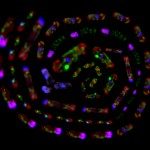Lien vers Pubmed [PMID] – 15686568
Mol. Microbiol. 2005 Feb;55(4):1246-58
The pathogenic yeast Candida glabrata is able to bind in vitro to human epithelial cells. This interaction depends on expression of the adhesin Epa1p. The genome contains a number of EPA1 paralogues which localize to the subtelomeric regions of the C. glabrata. We have identified three hyperadherent mutants of C. glabrata. The first has an insertion adjacent to EPA7, an EPA1-related adhesin. The others disrupt the SIR3 and RIF1 genes of C. glabrata. We show that SIR3 and RIF1 are required for subtelomeric silencing in C. glabrata and that RIF1 regulates telomere length in C. glabrata. We show that the hyperadherent phenotype of the sir3Delta and rif1Delta deletion strains depends primarily on derepression of two novel members of the EPA gene family -EPA6 and EPA7. The sir3Delta and rif1Delta mutants show increased colonization of the kidney in a murine model of disseminated infection and this hypercolonization depends, at least in part, on derepression of EPA6 and EPA7. The analysis here is the first evidence that multiple EPA genes encode adhesins and demonstrates that transcription of at least two of these adhesins is regulated by subtelomeric silencing.

